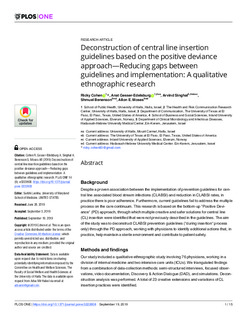| dc.contributor.author | Cohen, Ricky | |
| dc.contributor.author | Gesser-Edelsburg, Anat | |
| dc.contributor.author | Singhal, Arvind | |
| dc.contributor.author | Benenson, Shmuel | |
| dc.contributor.author | Moses, Allon E. | |
| dc.date.accessioned | 2020-03-04T13:27:41Z | |
| dc.date.available | 2020-03-04T13:27:41Z | |
| dc.date.created | 2019-09-20T10:01:57Z | |
| dc.date.issued | 2019 | |
| dc.identifier.citation | PLOS ONE. 2019, 14 (9). | nb_NO |
| dc.identifier.issn | 1932-6203 | |
| dc.identifier.uri | http://hdl.handle.net/11250/2645282 | |
| dc.description | This is an open access article distributed under the terms of the Creative Commons Attribution License, which permits unrestricted use, distribution, and reproduction in any medium, provided the original author and source are credited. | nb_NO |
| dc.description.abstract | Despite a proven association between the implementation of prevention guidelines for central line associated blood stream infections (CLABSI) and reduction in CLABSI rates, in practice there is poor adherence. Furthermore, current guidelines fail to address the multiple process on the care continuum. This research is based on the bottom-up "Positive Deviance" (PD) approach, through which multiple creative and safer solutions for central line (CL) insertion were identified that were not previously described in the guidelines. The aim of the study was to deconstruct CLABSI prevention guidelines ("during insertion" process only) through the PD approach, working with physicians to identify additional actions that, in practice, help maintain a sterile environment and contribute to patient safety.
Our study included a qualitative ethnographic study involving 76 physicians, working in a division of internal medicine and two intensive care units (ICUs). We triangulated findings from a combination of data-collection methods: semi-structured interviews, focused observations, video documentation, Discovery & Action Dialogue (DAD), and simulations. Deconstruction analysis was performed. A total of 23 creative extensions and variations of CL insertion practices were identified.
The PD approach enables the identification of vital nuggets of hidden wisdom missing from the formal explicit CLABSI guidelines, and therefore helps bridge the gap between theory and praxis. During the guideline’s deconstruction process, through collaborative staff learning, the written procedure is transformed into a living, breathing and cooperative one. It can reduce hospital stays and save lives, and therefore needs careful attention of healthcare scholars and practitioners. | nb_NO |
| dc.language.iso | eng | nb_NO |
| dc.relation.uri | https://journals.plos.org/plosone/article/file?id=10.1371/journal.pone.0222608&type=printable | |
| dc.rights | Navngivelse 4.0 Internasjonal | * |
| dc.rights.uri | http://creativecommons.org/licenses/by/4.0/deed.no | * |
| dc.subject | positive deviance | nb_NO |
| dc.subject | central line insertion guidelines | nb_NO |
| dc.title | Deconstruction of central line insertion guidelines based on the positive deviance approach—Reducing gaps between guidelines and implementation: A qualitative ethnographic research | nb_NO |
| dc.type | Journal article | nb_NO |
| dc.type | Peer reviewed | nb_NO |
| dc.description.version | publishedVersion | nb_NO |
| dc.subject.nsi | VDP::Samfunnsvitenskap: 200 | nb_NO |
| dc.source.pagenumber | 15 | nb_NO |
| dc.source.volume | 14 | nb_NO |
| dc.source.journal | PLOS ONE | nb_NO |
| dc.source.issue | 9 | nb_NO |
| dc.identifier.doi | 10.1371/journal.pone.0222608 | |
| dc.identifier.cristin | 1727056 | |
| dc.relation.project | Israel National Institute for Health Policy Research to AGE: 2016\134\א | nb_NO |
| cristin.unitcode | 209,6,4,0 | |
| cristin.unitname | Institutt for organisasjon, ledelse, styring | |
| cristin.ispublished | true | |
| cristin.fulltext | original | |
| cristin.qualitycode | 1 | |

